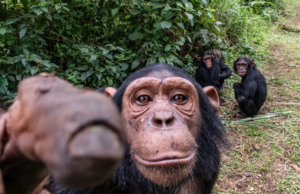The wild chimpanzee who cared for her child with disability

In the first case of its kind, a female chimpanzee has been observed caring for an infant with severe disabilities in the wild.
The young chimpanzee was discovered in Mahale Mountains National Park in Tanzania. Known as XT11, she lived for 23 months.
She was the sixth child of her 36-year-old mother, Christina.
Physically, XT11 was similar to a captive chimpanzee that had symptoms similar to Down Syndrome.
It seems likely that XT11 only lived as long as she did because of the care provided by her mother, and that she would not have survived without it.
Reporting in the journal Primates, researchers say that the mother “responded to XT11’s abnormal behaviours, limited abilities and needs”.
She was not observed eating any plants, so she remained completely dependent on her mother’s milk long after a baby chimp would usually have been weaned.
“We suspect that her feeding limitations were due to her lack of motor ability and that she might have suffered from a lack of nutrition because of her milk diet, at least in her latter life,” the authors report.
As well as her limited physical abilities, XT11 had an abdominal hernia on her stomach (see above), spinal damage and an extra, inactive finger on her left hand.
Her eyes looked empty, her mouth was often half open, and she was unable to sit without support.
She was able to hold onto her mother’s hair, but her feet did not have enough strength to grip, so she mostly dangled.
Caring for a disabled infant forced Christina to change her behaviour. She stopped fishing for ants in trees, because she needed her hands free to carry XT11.
“The mother of a severely disabled infant probably experiences more stress than other mothers because she must provide intensive care for longer,” the authors write.
Occasionally, XT11’s 11-year-old sister helped out: she played with her, groomed and carried her.
“There were some cases where the mother spontaneously gave the infant to the elder daughter. This is quite unusual for a mother to do,” says Michio Nakamura, co-author of the study from Kyoto University, Japan.
“While the elder sister was taking care of the disabled infant, the mother climbed on a tree to feed on fruits,” he told BBC Earth.
But when her sister had her own child, this extra care stopped.
XT11’s relatives were not allowed to groom or carry her, which is unusual. The mother may have understood that it would not be safe for others to carry her child, as they did not fully understand her needs.
The cause of her death is unclear. It may have been due to complications brought on by her limited diet.
Although it is not uncommon for primates to be born with disabilities, only two chimpanzee infants with disabilities have been observed previously.
Both were captive. They were neglected or rejected by their mothers, so humans helped to care for them. One died at 17 months: the other reached 24 months but only after receiving several blood transfusions.
That such care has now been witnessed in the wild, in our closest living relatives, hints that this behaviour has a long evolutionary history. Our common ancestor with chimpanzees may have displayed similar levels of care.
“Our observation that the elder sister took care of the disabled infant might shed light on how non-maternal care to disabled individuals evolved,” says Nakamura.
http://www.bbc.com/earth/story/20151112-a-wild-chimp-cares-for-her-disabled-child

 Español
Español
 Português
Português








